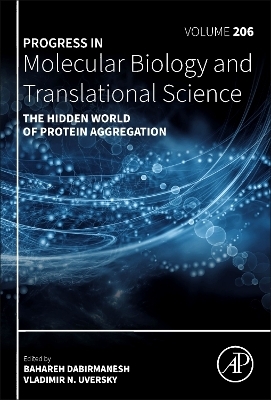
The Hidden World of Protein Aggregation
Academic Press Inc (Verlag)
978-0-443-29340-5 (ISBN)
Additional sections cover Experimental Techniques for Detecting and Evaluating the Amyloid Fibrils, Prediction of Protein Aggregation, Amyloid Fibril Cytotoxicity and Associated Disorders, Inhibitors of Amyloid Fibril Formation, Therapeutic Approaches in Proteinopathies, Functional Amyloids, Biotechnological Applications of Amyloid Fibrils, and The Hidden World of Protein Aggregation.
David B. Teplow, Ph.D., is a Professor of Neurology, Emeritus, at UCLA and an internationally recognized leader in efforts to understand and treat Alzheimer's disease. Dr. Teplow's group has used a multi-disciplinary approach to determine how neurotoxic peptides, such as the amyloid β-protein (Alzheimer's disease) and α-synuclein (Parkinson’s disease), form neurotoxic structures that kill neurons and to develop the means to block these processes. Dr. Teplow received undergraduate training at UC Berkeley; a Ph.D. from the University of Washington; and was a postdoctoral scholar at Caltech. Before coming to UCLA, Dr. Teplow was a faculty member in the Department of Neurology, Harvard Medical School. Dr. Teplow has published >250 peer-reviewed articles, books and book chapters, and commentaries, in addition to serving on numerous national and international scientific advisory boards. Dr. Teplow was a founding editor of the Journal of Molecular Neuroscience and Current Chemical Biology, He is Co-Editor-in-Chief of the Elsevier serial Progress in Molecular Biology and Translational Science and is Associate Editor-in-Chief of the American Journal of Neurodegenerative Disease. Bahareh Dabirmanesh received her Ph.D. in Biochemistry from Tarbiat Modares University (Tehran-Iran) in 2013. Following the completion of her doctoral studies, she joined the University as an academic member pursuing both academic and research activities within the Department of Biochemistry, Faculty of Biological Sciences. During this period, she undertook the responsibilities of a supervisor or advisor for a considerable number of master's and PhD theses. Since 2022, she has held the position of associate professor. Her research interests are mainly focused on protein engineering, macromolecular interactions, structure-function relation, amyloidogenic proteins, Biotherapeutics, protein pathways and signaling cascades Prof. Vladimir N. Uversky, PhD, DSc, FRSB, FRSC, FAIMBE, Professor at the Department of Molecular Medicine, Morsani College of Medicine, University of South Florida (USF), is a pioneer in the field of protein intrinsic disorder. He has made a number of groundbreaking contributions in the field of protein folding, misfolding, and intrinsic disorder. He obtained his academic degrees from Moscow Institute of Physics and Technology (Ph.D., in 1991) and from the Institute of Experimental and Theoretical Biophysics, Russian Academy of Sciences (D.Sc., in 1998). He spent his early career working mostly on protein folding at the Institute of Protein Research and the Institute for Biological Instrumentation (Russia). In 1998, moved to the University of California Santa Cruz. In 2004, joined the Indiana University-Purdue University Indianapolis as a Senior Research Professor. Since 2010, Professor Uversky is with USF, where he works on various aspects of protein intrinsic disorder phenomenon and on analysis of protein folding and misfolding processes. Prof. Uversky has authored over 1250 scientific publications and edited several books and book series on protein structure, function, folding, misfolding, and intrinsic disorder. He is also serving as an editor in a number of scientific journals. He was a co-founder of the Intrinsically Disordered Proteins Subgroup at the Biophysical Society and the Intrinsically Disordered Proteins Gordon Research Conference. Prof. Uversky collaborated with more than 12,500 colleagues from more than 2,750 research organizations in 89 countries/territories.
Preface
Bahareh Dabirmanesh and Vladimir N. Uversky
1. Protein Aggregation: An Overview
Vladimir N. Uversky
2. Pathways of Amyloid Fibril Formation and Aggregation
Bahareh Dabirmanesh and Fatemeh Aziziyan
3. Factors Influencing Amyloid Fibril Formation
Khosro Khajeh and Fatemeh Aziziyan
4. Morphological Features and Types of Aggregated Structures
Vladimir N. Uversky
5. Each big journey starts with a first step: Importance of Oligomerization
Vladimir N. Uversky
6. Liquid-Liquid Phase Separation as Triggering Factor of Fibril Formation
Vladimir N. Uversky
7. Experimental Techniques for Detecting and Evaluating the Amyloid Fibrils
Bahareh Dabirmanesh and Farnoosh Farzam
8. Prediction of Protein Aggregation
Khosro Khajeh
9. Amyloid Fibril Cytotoxicity and Associated Disorders
Khosro Khajeh
10. Inhibitors of Amyloid Fibril Formation
Khosro Khajeh and Fatemeh Aziziyan
11. Therapeutic Approaches in Proteinopathies
Vladimir N. Uversky
12. Functional Amyloids
Bahareh Dabirmanesh
13. Biotechnological Applications of Amyloid Fibrils
Bahareh Dabirmanesh
14. The Hidden World of Protein Aggregation
Bahareh Dabirmanesh and Vladimir N. Uversky
| Erscheinungsdatum | 22.08.2024 |
|---|---|
| Reihe/Serie | Progress in Molecular Biology and Translational Science |
| Mitarbeit |
Herausgeber (Serie): David B. Teplow |
| Verlagsort | San Diego |
| Sprache | englisch |
| Maße | 152 x 229 mm |
| Gewicht | 950 g |
| Themenwelt | Naturwissenschaften ► Biologie ► Biochemie |
| Naturwissenschaften ► Biologie ► Genetik / Molekularbiologie | |
| ISBN-10 | 0-443-29340-6 / 0443293406 |
| ISBN-13 | 978-0-443-29340-5 / 9780443293405 |
| Zustand | Neuware |
| Haben Sie eine Frage zum Produkt? |
aus dem Bereich


